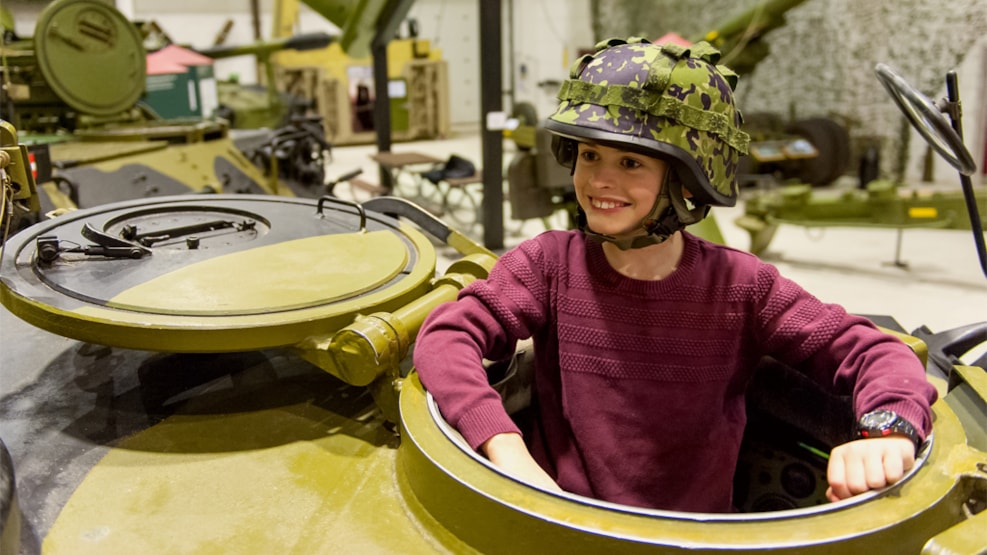
Panser- & Artillerimuseum
At the Panser- & Artillerimuseum you can unleash your inner geek and get up close to the most exciting tanks and guns - and the best stories
Do you know the American Sherman tank that served on the front lines during World War II? Or the British Centurion tank, which for many years was the army's most powerful tank? There's also the famous 'White Leopard' that took part in a skirmish near Tuzla in Bosnia and Herzegovina, the so-called Honest John rocket from the Cold War and a bronze cannon from the time of the absolute monarchy. And then there are uniforms from the Second World War to the present day, small models and a wealth of exciting stories about Danish war history, which you can get up close to in the Armour and Artillery Museum in Oksbøl.
The army's wheeled vehicles
During the occupation, the German Wehrmacht disbanded the Danish army and took approximately 1500 vehicles, motorcycles and armoured cars into their custody. After liberation in 1945, the Danish army was rebuilt with Swedish wheeled vehicles brought from Sweden by the Danish Brigade. These were subsequently supplemented by second-hand British and Canadian equipment for the Danish units that were to be deployed in the Allied occupation zones in Germany from 1947-1958.
But it was with Denmark's membership of NATO in 1949, the arms aid and the Defence Act of 1951 that the starting shot was fired to build the mobile army we know today. In the exhibition The Army's Wheeled Vehicles, you can get up close and personal with the various wheeled vehicles used in the army from 1945 until autumn 2000. You also have the opportunity to climb into an armoured personnel carrier and get a sense of how little space the soldiers have.
Armour
In the hall you will see a number of the tanks that have been used in the Danish army since Denmark joined NATO in 1949. Here you can see the American Sherman tank, which first served on the Western Front in World War II and from 1950 also in Denmark. It was replaced by the British Centurion tank, which for many years was the army's most powerful tank until it was replaced by the German Leopard tanks. In the hall, you can also see an example of the famous 'White Leopard', which took part in a skirmish near Tuzla in Bosnia-Herzegovina - the so-called 'Operation Bulwark'.
The Cold War
The Cold War was the major political conflict that defined the period between the end of World War II in 1945 until the fall of the Berlin Wall in 1989. The conflict was between the two superpowers, the United States and the Soviet Union, along with their allies. The Cold War never became a hot war, as it did not develop into the devastating nuclear war that many feared. In the Cold War exhibition, you can see the guns from the period. They range from the small mobile 105 mm cannon to a self-propelled howitzer M109 and a 203 mm howitzer, which is the heaviest weapon used by the Danish artillery. The exhibition also features the large American MGR I Honest John rocket, which was part of the Danish artillery from 1960. The Honest John rocket could deliver a nuclear charge and reminds us of the seriousness of the Cold War.
You have the opportunity to climb into a self-propelled howitzer armoured personnel carrier designed as a firing centre and to wear a fragmentation vest and a Kevlar helmet.
Experience the history of guns
Artillery is the hard stuff. In Europe, the use of cannons dates back to the Middle Ages and has been used on fortresses and ships. In modern times, artillery, i.e. the largest cannons, have typically been used to support the front line in war situations. The exhibition includes cannons dating back to the Middle Ages, such as the Anholt cannon, through the beautiful old bronze cannons from the time of the absolute monarchy to fortress cannons from the Copenhagen fortifications. And the cannons hide a great deal of cultural history - why were some cannons decorated with elephants and dolphins, for example? And why was one of the cannons called the "women's cannon"?
You can keep up to date with events, activities and tank demonstrations on the Facebook page of the Armour and Artillery Museum.